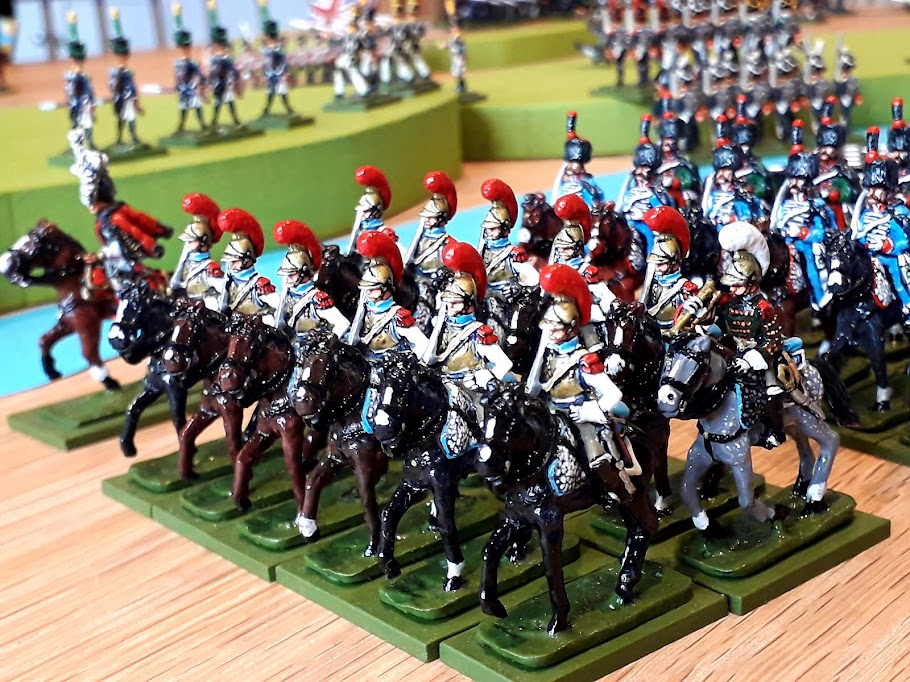I have put my thoughts on paper (well this blog at least) regarding my Napoleonic changes to the classic Charge rules. These are based on the Napoleonic Supplementary rules published in the Athena version of the Charge rules plus some of my own ideas thrown in.
UNIT ORGANISATION.
I use half scale units with Infantry having 24 figures. Cavalry with 12 figures, in 2 squadrons of 6, and Light Infantry with 12 in 2 companies of 6. Artillery is a gun and 4 crew.
Cavalry and Light Infantry can operate as 2 single 6 figure squadrons or companies as required but cannot then rejoin to form a consolidated unit.
MOVEMENT
All unit movement is reduced by 50%.
Infantry:
Move and Fire
3”
Battalion in Line
4 ½”
Battalion in square
4 ½”
Company in Line
6”*
Column of fours
7 ½”
File, single file
7 ½”
* A infantry company is 8 figures operating way from its battalion.
Light Infantry in open order:
Move and Fire
6”
Move without firing
12”
Line Artillery:
Move and even chance to fire
3”
Move deployed without firing
6”
Move in column of route
7 ½”
Horse Artillery
Move and even chance if fire 6"
Move deployed without firing 9"
Move in column of route 12"
Cavalry:
Heavy Cavalry
12”
Light Cavalry
15”
Staff
15”
Train:
Waggons
6”
Mules
6”
Notes.
a)
Infantry changing formation: no figure may move more than 6”
b)
Infantry squares must be 2 ranks deep on each face, and may not move if engaged in firing or melee.
c)
Light Infantry in open order must be a minimum of 1” apart. If in close order they move an fire as line.
d)
Cavalry suffer no penalties for changing formation, and formation does not affect their speed of movement.
e)
The Artillery’s “move deployed without firing” equates to move and unlimber , or limber up and move.
FIRING
All firing distances are reduced by 50%
INFANTRY MELEE
When using the Infantry Melee resolution for large numbers of figures, rather than the individual combats, use the following dice per figure.
Guards one D6 per 4 figures
Line one D6 per 5 figures
Militia one D6 per 6 figures.
The total is then halved to determine the number of figures lost.
For loss from firing and melee I round down for under half a figure, round up for other half and roll an extra dice requiring a 4,5 or 6 to round up a half casualty.
INDIVIDUAL FIGURE MELEES
When resolving individual melees, such as Cavalry vs Cavalry or Light Infantry vs Light Infantry I use the following additional rules
I give a plus +1 to the dice score of the side that has the net advantage in the melee. The net advantage, if any, is by determining by assessing the following factors.
Heavy vs Light Cavalry
Lancers in 1st round of melee.
Better morale class than opponent
Defending an obstacle
Cavalry and Infantryman vs Cavalry
So for instance an elite cavalry man fighting a heavy line cavalry man would be one advantage each so no net advantage where as if the light cavalry and heavy were both line the heavy cavalryman would be +1.
The maximum advantage can never be greater than +1 so an elite heavy against a line light will only be +1.
This rule allows better quality troops a slight advantage in melee.
ADDITIONAL RULES
1.
RIFLEMEN
Two factors are recognised for the rifle- accuracy of fire and relatively slow rate. It is assumed rifles will only be used in company strength, attached to infantry brigades.
Move and fire as Light Infantry, but riflemen fire only on alternate moves:
0-3”
3 4 5 6
Kills 1 man
3-6”
4 5 6
Kills 1 man
6-9”
5 6
Kills 1 man
2.
HOWITZERS
Generally speaking, howitzers made up 1/6th of the artillery arm of an army, so this proportion should be maintained. Howitzers may be foot or horse artillery and all are assumed to be of the same calibre. Crew of 4.
Ranges:
30” maximum
12” minimum
Range
Dice for hit
as usual
Dice for effect
12-18”
2 3 4 5 6
In all cases the dice score stands
18-24”
4 5 6
24-30”
6
Effect dice are subject to the usual halving for cavalry, gunners etc. Casualties are taken from the centre of the target.
Overhead fire: a howitzer may engage any target provided it is not within 3” of the lee side of a building, hill, wood, etc. and that the trajectory of the shell does not pass within 1” of friendly troops.
3.
GUARD ARTILLERY
a)
Crew of 4.
b)
Effect dice +1.
c)
Move as foot artillery







